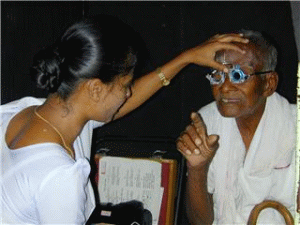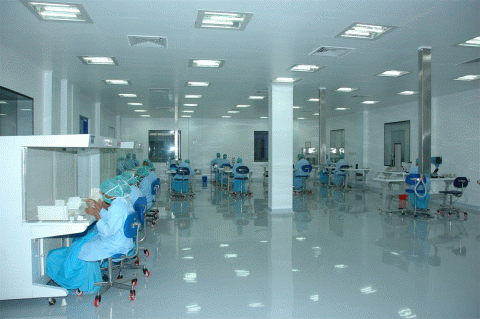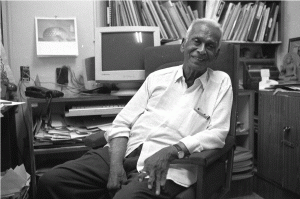When most of us retire, we just hang up our boots and call it a day. It is our way of telling ourselves that we have worked for the most years of our lives and it is time to now slow down, get some health insurance, read and relax.
But, see what Dr Govindappa Venkataswamy did after retirement in 1976 after working in numerous government hospitals in Tamilnadu. The day he retired, he started drawing blueprints of what he always wanted to do: reach inexpensive eye care to the poor. This was his dream all through his working years, a dream that was born while traveling through the United States. There he had seen a modern eye-care facility and he wanted a similar one in India. Now that he had retired, it was time to do it, he told himself.

![]() Villager at a free eye camp. Pic: Rajkumar, Aravind Eye Hospital, Madurai.
Villager at a free eye camp. Pic: Rajkumar, Aravind Eye Hospital, Madurai.
After all, he argued, the government cannot be expected to meet the health needs of all. He formed a trust under which the Aravind Eye Hospital was founded in 1976 with a mission to eliminate needless blindness. He chose the name Aravind wanting to name it after Sri Aurobindo who was involved with Indias freedom struggle and later became a revered spiritual leader.
Small beginnings
Venkataswamy always said that of the 12 million blind in India, 9.6 million could easily be treated, as cataract, which was the major reason, could be set right by a simple operation. But for that, he needed a hospital. He did not have the money to build one and so set up one in his rented house at Theni near Madurai in Tamilnadu. It had just 11 beds and was always full. He knew this was not enough to tackle the challenge and persuaded his family to pawn the family jewellery to garner funds. To start with, he built just one floor of the hospital. That was 31 years ago.
Time flies. No one at that time ever imagined that this was the beginning of the chain of hi-tech Aravind Eye Hospitals in south India. It was destined to as Dr Venkataswamy meticulously built not just a dozen hospitals, but also a work culture where the philosophy is care. Today, his hospitals are among the best in the country.
Thriving network
Aravind today is a thriving network of hospitals and satellite clinics that provide eye exams and surgeries, train health care professionals, conduct research, and manufacture eye care products. Since the last four years, Aravind has used high-speed broadband access to link the eye camps they organise with doctors in hospitals so that patients can get the much required immediate expert advice. It saves many from a trip to the hospital.
The Aravind Eye Care System (AECS) is today one of the largest and most productive eye care facilities in the world, in terms of surgical volume and the number of patients treated. Today AECS encompasses five hospitals with a total bed capacity of 3,900, four managed eye hospitals, a manufacturing centre for ophthalmic products, an international research foundation and a resource and training centre that is revolutionising hundreds of eye care programmes across the developing world. Apart from Madurai, there are now hospitals at Theni, Tirunelveli, Coimbatore and Pondicherry. Till March 2008, 2,396,100 outpatients were treated and 285,745 surgeries were performed.

Aravind has latest techniques in research and development.
Pic: Thirunavukkarasu, Aurolab.
What is interesting is that each hospital has medical teams fanning out into rural areas to conduct free eye camps to detect eye problems before they become serious. Patients are screened for various eye diseases; those who require surgery are transported to the base hospital, treated, returned to the campsite and followed up after six weeks. All this is free. Till March 2008, as many as 2701 camps were conducted through which 6, 33,283 patients were screened and 98,444 patients underwent surgery.
International recognition
In late May, the Bill and Melinda Gates Foundation gave its presitigious $ 1 million Gates Award for Global Health to the Aravind Eye Care System in recognition of its groundbreaking work to prevent debilitating blindness and provide affordable world class eye care to the poor. The award was presented in the last week of May at the Global Health Councils 35th Annual International Conference in Washington DC. Bill and Melinda Gates established the Gates Award for Global Health in 2000 to applaud exemplary work in international health. The award is the worlds largest prize for improving health in developing countries. Dr Perumalsamy Namperumalsamy, chairman of Aravind Eye Hospitals, hopes that this award will encourage others to develop creative, sustainable solutions to blindness and other global health challenges.
It was a richly deserved award. Mainly because of Aravinds concerted efforts, the number of legally blind people in India declined by 25 per cent from 8.9 million in 1990 to 6.7 million in 2002.
Modern, yet inexpensive eye care
In the late 1980s, intra-ocular lenses (IOL) - artificial lenses to replace cataract-ridden natural lenses - appeared on the scene. Each IOL was imported for $600. Dr. Venkataswamy realised poor patients just could not afford it and so set about getting his team to do research. By 1992, he was able to produce 37,000 lenses a year. Today about 2,500 lenses are produced each day and exported to 120 countries at an incredible price of $5 each.
Despite being ultra modern, the Aravind Eye Hospitals are not expensive. As a result of a unique fee system and effective management, Aravind is able to provide free eye care to 60 per cent of its patients from the revenue generated from its 40 per cent paying patients. Two thirds of patients who come are so poor that they cannot pay. So they are allowed to take free treatment and leave. The rest one third pay as much as at any other hospital. This was all the money that Dr. Venkataswamy needed to run it like a top class healthcare system.
It is little wonder then that Harvard uses the Aravind chain of hospitals as a case study to teach the concept of management and excellence. Each doctor averages 2,000 surgeries a year against the national average of 220. And while the cost of doing a routine cataract operation (with lens replacement) by a private practitioner is Rs.2,000-5,000, it costs only Rs 750-900 at Aravind. The comparable rate in the US is about $2,000.
Excellence is the word they all rally for. The Aravind Eye Hospital, Madurai can accommodate 280 paying patients and 1100 free patients. It has full-fledged super-specialty clinics manned by highly qualified specialists. This is the headquarters for the Madurai Eye Bank Association, which receives eyeball donations from various institutions in India and from the USA.
Sustainable and replicable
This is a sustainable model inspite of the fact that nearly two thirds of the patients are treated free of cost. What Dr. Venkataswamy used was old age business strategies - he increased volumes, built efficiencies and reduced costs making every employee realise that every rupee saved helps in treating more patients. His passion for eradicating blindness was contagious and staff members took it up as a mission.
A new technology, based on Wi-Fi wireless networks, allows eye specialists at Aravind Eye Hospital at Theni to interview and examine patients in five remote clinics via high-quality videoconferencing. The plan is to link all Aravind Hospitals to 50 clinics so that atleast half a million patients can be benefited.
Such IT solutions in spreading healthcare hold tremendous potential. Patients after being screened by a nurse, spend a few minutes talking to a Aravind Hospital doctor on a web camera. If the doctor feels that a closer examination or an operation is necessary, then a hospital appointment is granted. Basically, this was an idea the hospitals brought in, as it was the only way to reach 70 percent of its target rural population, which would only travel to a hospital if something were serious.
An Aravind Hospital study done a couple of years ago found that following treatment 85 per cent of the men and 58 per cent of the women who had lost jobs because of poor eyesight, were taken back after recovery.
Attention to detail

![]() Late Dr Venkataswamy - the inspiration at Aravind. Pic credit: Moses Caesar.
Late Dr Venkataswamy - the inspiration at Aravind. Pic credit: Moses Caesar.
Dr Venkataswamy took care to interview every employee who was to be hired. He did it as he said that he needed employees who would have an empathic attitude towards the institution and patients. Though he is no more, the HR head now interviews even a sweeper in the Aravind Hospitals, to ascertain that s/he has the right attitude. Only then can the end product of what they do turn out to be the best.
His leadership inspired so many health professionals. Dr V, as he was popularly known, had severe rheumatoid arthritis. His fingers were seriously affected and out of shape. But he found creative ways of holding surgical instruments with his fingers while operating. He performed over one lakh surgeries successfully.
Dr V was internationally feted and nationally recognised with a Padmashree. But all he cared for was reaching eye care to all those who needed it. He died last year at the age of 86 after working every day of his life. It was a life fully lived, a life that had infinite vision.
























